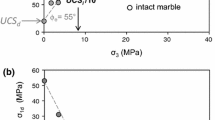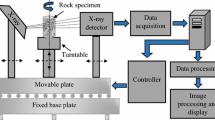Abstract
Rock and geomaterial specimens are usually extracted in circular cores. KIc derived from various core specimens is discussed. A newly developed fracture toughness test specimen, semi-circular in shape and contains an edge-crack, is elaborated. The fracture load and the fracture energy of a typical layered rock are measured with static tests, and the fracture toughness is determined using a stress intensity factor method, a compliance method and a J-integral based method. A minimum dimensional requirement is proposed for plane strain fracture toughness. Application of KIc in fragmentation modeling is illustrated. Mixed mode fracture specimen is also presented.
Access this chapter
Tax calculation will be finalised at checkout
Purchases are for personal use only
Preview
Unable to display preview. Download preview PDF.
Similar content being viewed by others
References
Standard Method of Test for Plane Strain Fracture Toughness in Metallic Materials, ASTM E399 — 81, Am. Soc. for Testing and Materials, New York (1981).
M. Wecharatana and S. P. Shah, Prediction of nonlinear fracture process zone in concrete, Journal of EMD of ASCE 109, 1231–1246 (1983).
F. Ouchterlony, co-ordinator, Suggested Methods for Determining Fracture Toughness of Rock Materials, Int. Soc. Rock Mech. Commi. Testing Methods, 4th draft, June (1986).
L. M. Barker, A simplified method for measuring plane strain fracture toughness, Engng. Fracture Mech. 9, 361–369 (1977).
R. J. Clifton, E. R. Simonson, A. H. Jones, and S. J. Green, Determination of the critical stress intensity factor KIc from internally -Pressurized thick-walled vessels, Exper. Mech. 16, 233–238 (1976).
F. Ouchterlony, A new core specimen for the fracture toughness testing of rock, Swedish Detonic Research Foundation Rep., DS 1980: 17, Stockholm, Sweden (1980).
F. Ouchterlony and Sun Zongqi, New methods of measuring fracture toughness on rock cores, Swedish Detonic Research Foundation Rep, DS 1983: 10, Stockholm, Sweden (1983).
K. P. Chong and M. D. Kuruppu, New specimen for fracture toughness determination of rock and other materials, Int. J. Fract. 26, R 59–R 62 (1984).
K. P. Chong and J. W. Smith, eds, Mechanics of Oil Shale, Elsevier (1984).
E. R. Simonson, A. S. Abou-Sayed and R. J. Clifton, Containment of massive hydraulic fractures, SPE paper No. 6089, 51st Annual Fall Meeting of SPE of AIME (1976).
H. P. Rossmanith, Rock Fracture Mechanics, Springer — Verlag, Wien, New York (1983).
F. Ouchterlony, Fracture Mechanics applied to rock blasting, Proceedings 3rd Int. Congress of the ISRM, Denver, Colorado, 2-B, 1377–1383 (1974).
K. P. Chong, P.M. Hoyt, J. W. Smith and B.Y. Paulsen, Effects of strain rate on oil shale fracturing, Int. J. Rock Mech. Min. Sci 17, 35–43 (1980).
R A. Schmidt, Fracture toughness of limestone, Exper. Mech. 16, 161–167 (1976).
P.J Hommert, ed., Oil Shale Program Quarterly Reports, October, 1983 September, 1984, Sandia National Laboratories Reports, SAND84-1561 and SAND85-1170 Albuquerque, August (1985).
J. S. Kuszmaul, Numerical modeling of oil shale fragmentation experiments, Proceedings 11th Annual Society of Explosives Engineers Conf., C. S. Konya, ed., San Diego, California (1985).
M. E. Kipp, D.E. Grady and E. P. Chen, Strain-rate dependent fracture initation, Int. J. Fract. 16, 471–478 (1980).
M. D. Kuruppu and K. P. Chong, New specimens for modes I and II fracture investigations of geomaterials, Proceedings Soc. Exp. Mech, Spring Conf., New Orleans, U. S. A., 31–38, June (1986).
K. P. Chong, J. W. Smith, E. S. Borgman, Tensile strengths of Colorado and Utah oil shales, J. of Energy, AIAA, Vol. 6, No. 2, 81–85, March/Apr. (1982).
K. P. Chong, J. P. Turner and G. F. Dana, Strain-rate effects on the mechanical properties of Utah oil shale, Proceedings Int. Symp. Mechanical Behavior Structural Media, Ottawa, Canada, 431–446 (1981).
K. P. Chong, K. Uenishi, J W. Smith and A. C. Munari, Non-linear three dimensional mechanical characterization of Colorado oil shale, Int. J. Rock Mech. Min. Sci 17, 339–347 (1980).
J. W. Smith, Relationship between rock density and volume of organic matter in oil shales, US DOE report ERDA/LERC/RI-76/6. Laramie, Wyoming (1976).
J. R. Dixon and J. S. Strannigan, Determination of energy release rates and stress intensity factors by the finite element method, J. Strain Analysis 7, 125–131 (1972).
C. W. Woo and M. D. Kuruppu, Use of finite element method for determining stress intensity factors with a conic-section simulation model of crack surface, Int. J. Fract. 20, 163–178 (1982).
P. C. Paris and G. C. Sih, Stress analysis of cracks, in Symposium on Fracture Toughness Testing and Its Application, ASTM STP 381, 30–38 (1970).
J. B. Sellers, G. R. Haworth and P. G. Zambas, Rock mechanics research on oil shale mining, Transactions Soc. Min. Engineers of AIME 252, 222–232 (1972).
J. R. Rice, A path-independent integral and the approximate analysis of strain concentration by notches and cracks, Transactions ASME J. App. Mech 35, 379–386 (1968).
C. P. Cherepanov, Crack propagation in continuous media, J. App. Math. Mech (PMM) 31, 476–488 (1967).
J. R. Rice, P. C. Paris and J. G. Merkle, Some further results of J-integral analysis and estimates, in Progress in Flaw Growth and Fracture Toughness Testing, ASTM STP 536, 231–245 (1973).
L. S. Costin, Static and dynamic fracture behavior of oil shale, in Fracture Mechanics Methods for Ceramics, Rocks and Concrete, ASTM STP 745, 169–184 (1981).
C. Young, N. C. Patti and B. C. Trent, Stratigraphic variations in oil shale fracture properties, US DOE Report of Investigation, DOE/LC/RI-82-5, Laramie, Wyoming (1982).
V. C. Li, Fracture resistance parameters for cementitious materials and their experimental determinations, Applications of Fracture Mechanics to Cementitious Composites, S. P. Shah, ed., Martinus Nijhoff Publ., 431–449 (1985).
Y. S. Jenq and S. P. Shah, Nonlinear fracture parameters for cement based composites: theory and experiments, Applications of Fracture Mechanics to Cementitious Composites, S. P. Shah, ed., Martinus Nijhoff Publ. (1985).
D. Grady, The mechanics of fracture under high-rate stress loading, in Mechanics of Geomaterials, John Wiley & Sons Ltd., (1985).
L. M. Taylor, E. P. Chen, and J. S. Kuszmaul, Microcrack-induced damage accumulation in brittle rock under dynamic loading, Computer Methods in Applied Mechanics and Engineering, Vol. 55, No. 3, 301–320, (1986).
L. M. Taylor and D. P. Flanagan, PRONTO2D--A Two-Dimensional Transient Solid Dynamics Program, in preparation.
E. Gorham-Bergeron, private communication, (1985).
J. S. Kuszmaul, “A Technique for Predicting Fragmentation and Fragment Sizes Resulting from Rock Blasting”, in preparation.
Author information
Authors and Affiliations
Editor information
Editors and Affiliations
Rights and permissions
Copyright information
© 1989 Springer-Verlag New York Inc.
About this paper
Cite this paper
Chong, K.P., Kuruppu, M.D., Kuszmaul, J.S. (1989). Fracture Toughness Determination of Rocks with Core-Based Specimens. In: Shah, S.P., Swartz, S.E. (eds) Fracture of Concrete and Rock. Springer, New York, NY. https://doi.org/10.1007/978-1-4612-3578-1_2
Download citation
DOI: https://doi.org/10.1007/978-1-4612-3578-1_2
Publisher Name: Springer, New York, NY
Print ISBN: 978-0-387-96880-3
Online ISBN: 978-1-4612-3578-1
eBook Packages: Springer Book Archive




